https://tinyurl.com/ybuvhfqt

Sculpture. Bharhut. A woman wears a necklacw with a pair of śrivatsa hieroglyphs. She also wears a head-cap/scarf. Scarf is an Indus Script hieroglyph: dhatu 'scarf' Rebus: dhatu 'mineral ore'

Another sculpture from Bharhut shows a yakshi wearing a head-cap/scarf and entwined with a tree.

Naginis. Bharhut. 200 BCE.

Sanchi sculptural frieze shows women wearing head-caps/scarves and venerating a tree-shrine. Two monkeys are also seen.
śrivatsa is Indus Script orthography of two fish-fins tied together.
khambhaṛā ʻfish-finʼ rebus: kammaṭi a coiner (Ka.); ... (CDIAL 13640) rebus: ಕಮ್ಮಟ kammaṭa 'mint' kambāṟa '
I suggest that the head-cap worn by the woman on the Bharhut sculptural frieze wears śrivatsa hypertext to signify veneration of blacksmithy. The tree associated with the woman in the following Bharhut frieze confirms the reading: kuṭi 'tree' rebus kuṭhi 'smelter'.
The head-caps worn by women in Bharhut and Sanchi sculptures are a continuum of the
tradition of Sarasvati civilization which shows terracotta figurines wearing comparable
head-caps.
 Tree shown on a tablet from Harappa. kuTi 'tree' Rebus: kuThi 'smelter'. In semantic expansion, tree as hieroglyph also signifies an armourer. कुठारु [p= 289,1] ‘a tree, a monkey, an armourer’ (Monier-Williams)
Tree shown on a tablet from Harappa. kuTi 'tree' Rebus: kuThi 'smelter'. In semantic expansion, tree as hieroglyph also signifies an armourer. कुठारु [p= 289,1] ‘a tree, a monkey, an armourer’ (Monier-Williams)
 Tree and other hieroglyphs, Harappa tablet h0480 A baTa'rimless pot' bhaTa 'worshipper' rebus: bhaTa 'furnace' PLUS kuṭi 'tree' rebus kuṭhi 'smelter' (Endless knot is: mēḍhā 'twist' rebus med 'iron' med '
Tree and other hieroglyphs, Harappa tablet h0480 A baTa'rimless pot' bhaTa 'worshipper' rebus: bhaTa 'furnace' PLUS kuṭi 'tree' rebus kuṭhi 'smelter' (Endless knot is: mēḍhā 'twist' rebus med 'iron' med '


 Terracotta femane figurines of Harappa wearing head-caps. Source of images: Courtesy tweet of Bharata @Sarvadamana of July 28, 2017
Terracotta femane figurines of Harappa wearing head-caps. Source of images: Courtesy tweet of Bharata @Sarvadamana of July 28, 2017
श्रीवत्सः 1 an epithet of Viṣṇu. -2 a mark or curl of hair on the breast of Viṣṇu; प्रभानुलिप्त- श्रीवत्संलक्ष्मीविभ्रमदर्पणम् R.1.1 (Apte) m. " favourite of श्री " N. of विष्णु L.; a partic. mark or curl of hair on the breast of विष्णु or कृष्ण (and of other divine beings ; said to be white and represented in pictures by a symbol resembling a cruciform flower) MBh. Ka1v. &c; the emblem of the tenth जिन (or विष्णु's mark so used) L. (Monier-Williams)
Variant (dotted circle w/ fish-fins on top constituting śrīvatsa):
Parker's Tissa coin Ancient Ceylon 54 shows śrivatsa hieroglyph ligatured to 'dotted circle' hieroglyph.
dhāī˜ (Lahnda) signifies a single strand of rope or thread.
I have suggested that a dotted circle hieroglyph is a cross-section of a strand of rope: S. dhāī f. ʻ wisp of fibres added from time to time to a rope that is being twisted ʼ, L. dhāī˜ f. Rebus: dhāˊtu n. ʻsubstance ʼ RV., m. ʻ element ʼ MBh., ʻ metal, mineral, ore (esp. of a red colour)ʼ; dhāū, dhāv m.f. ʻ a partic. soft red stone ʼ(Marathi) धवड (p. 436) [ dhavaḍa ] m (Orधावड ) A class or an individual of it. They are smelters of iron (Marathi). Hence, the depiction of a single dotted circle, two dotted circles and three dotted circles (called trefoil) on the robe of the Purifier priest of Mohenjo-daro.
The phoneme dhāī˜ (Lahnda) signifying a single strand may thus signify the hieroglyph: dotted circle. This possibility is reinforced by the glosses in Rigveda, Tamil and other languages of Baratiya sprachbund which are explained by the word dāya 'playing of dice' which is explained by the cognate Tamil word: தாயம் tāyam, n. < dāya Number one in the game of dice; கவறுருட்டவிழும் ஒன்று என்னும் எண்.
The semantics: dāya 'Number one in the game of dice' is thus signified by the dotted circle on the uttariyam of the pōtṟ पोतृ,'purifier' priest. Rebus rendering in Indus Script cipher is
 Satavahana coin shows two śrivatsa hieroglyphs.
Satavahana coin shows two śrivatsa hieroglyphs.
https://www.mintageworld.com/blog/satavahana-coins-symbols-motifs/
Other artefacts with śrivatsa hieroglyphs:



On Amaravati representation of the fiery pillar of light the skambha is ligatured with a capital on top. The capital is hieroglyph 'srivatsa' atop a circle (vaTTa 'round, circle') as a phonetic determinant that the aya PLUS kambha is in fact to be pronounced, aya khambhaṛā (Lahnda) rebus: aya 'iron' PLUS kammaTa 'mint' (Kannada)== 'fish PLUS fin' rebus: ayas kammaTa 'metal mint'. meḍ 'foot' rebus: meḍ 'iron' (Mu.Ho.)

 śrivatsa symbol [with its hundreds of stylized variants, depicted on Pl. 29 to 32] occurs in Bogazkoi (Central Anatolia) dated ca. 6th to 14th cent. BCE on inscriptions Pl. 33, Nandipāda-Triratna at: Bhimbetka, Sanchi, Sarnath and Mathura] śrivatsa symbol seems to have evolved from a stylied glyph showing ‘two fishes’. In the Sanchi stupa, the fish-tails of two fishes are combined to flank the ‘śrivatsa’ glyph. In a Jaina āyāgapaṭa, a fish is ligatured within theśrivatsa glyph composition, emphasizing the association of the ‘fish’ glyph with śrivatsa glyph. meṛh f. ʻ rope tying oxen to each other and to post on threshing floor ʼ (Lahnda)(CDIAL 10317) Rebus: mẽṛhẽt, meḍ 'iron' (Santali.Mu.Ho.) The m-sound in these lexemes explains the reason for the choice of taurine symbol to signify 'ma' syllable in Brāhmi script.
śrivatsa symbol [with its hundreds of stylized variants, depicted on Pl. 29 to 32] occurs in Bogazkoi (Central Anatolia) dated ca. 6th to 14th cent. BCE on inscriptions Pl. 33, Nandipāda-Triratna at: Bhimbetka, Sanchi, Sarnath and Mathura] śrivatsa symbol seems to have evolved from a stylied glyph showing ‘two fishes’. In the Sanchi stupa, the fish-tails of two fishes are combined to flank the ‘śrivatsa’ glyph. In a Jaina āyāgapaṭa, a fish is ligatured within theśrivatsa glyph composition, emphasizing the association of the ‘fish’ glyph with śrivatsa glyph. meṛh f. ʻ rope tying oxen to each other and to post on threshing floor ʼ (Lahnda)(CDIAL 10317) Rebus: mẽṛhẽt, meḍ 'iron' (Santali.Mu.Ho.) The m-sound in these lexemes explains the reason for the choice of taurine symbol to signify 'ma' syllable in Brāhmi script.
(After Plates in: Savita Sharma, 1990, Early Indian symbols, numismatic evidence, Delhi, Agama Kala Prakashan; cf. Shah, UP., 1975, Aspects of Jain Art and Architecture, p.77)

Sculpture. Bharhut. A woman wears a necklacw with a pair of śrivatsa hieroglyphs. She also wears a head-cap/scarf. Scarf is an Indus Script hieroglyph: dhatu 'scarf' Rebus: dhatu 'mineral ore'

Another sculpture from Bharhut shows a yakshi wearing a head-cap/scarf and entwined with a tree.

Naginis. Bharhut. 200 BCE.

Sanchi sculptural frieze shows women wearing head-caps/scarves and venerating a tree-shrine. Two monkeys are also seen.
śrivatsa is Indus Script orthography of two fish-fins tied together.
khambhaṛā ʻfish-finʼ rebus: kammaṭi a coiner (Ka.); ... (CDIAL 13640) rebus: ಕಮ್ಮಟ kammaṭa 'mint' kambāṟa '
I suggest that the head-cap worn by the woman on the Bharhut sculptural frieze wears śrivatsa hypertext to signify veneration of blacksmithy. The tree associated with the woman in the following Bharhut frieze confirms the reading: kuṭi 'tree' rebus kuṭhi 'smelter'.
The head-caps worn by women in Bharhut and Sanchi sculptures are a continuum of the
tradition of Sarasvati civilization which shows terracotta figurines wearing comparable
head-caps.
 Tree shown on a tablet from Harappa. kuTi 'tree' Rebus: kuThi 'smelter'. In semantic expansion, tree as hieroglyph also signifies an armourer. कुठारु [p= 289,1] ‘a tree, a monkey, an armourer’ (Monier-Williams)
Tree shown on a tablet from Harappa. kuTi 'tree' Rebus: kuThi 'smelter'. In semantic expansion, tree as hieroglyph also signifies an armourer. कुठारु [p= 289,1] ‘a tree, a monkey, an armourer’ (Monier-Williams)
Hieroglyph: kuṭhāru 'monkey' 'tree' Rebus: kuṭhāru 'armourer'. (kuṭhāru 'treasury' rebus: kuṭhāru 'armourer' koṭhāri 'crucible' Rebus: koṭhāri '
 Tree and other hieroglyphs, Harappa tablet h0480 A baTa'rimless pot' bhaTa 'worshipper' rebus: bhaTa 'furnace' PLUS kuṭi 'tree' rebus kuṭhi 'smelter' (Endless knot is: mēḍhā 'twist' rebus med 'iron' med '
Tree and other hieroglyphs, Harappa tablet h0480 A baTa'rimless pot' bhaTa 'worshipper' rebus: bhaTa 'furnace' PLUS kuṭi 'tree' rebus kuṭhi 'smelter' (Endless knot is: mēḍhā 'twist' rebus med 'iron' med '
Hieroglyph: kuṭa2 , °ṭi -- , °ṭha -- 3 , °ṭhi -- m. ʻ tree ʼ lex., °ṭaka -- m. ʻ a kind of tree ʼ Kauś.
Pk. kuḍa -- m. ʻ tree ʼ; Paš. lauṛ. kuṛāˊ ʻ tree ʼ, dar. kaṛék ʻ tree, oak ʼ ~ Par. kōṛ ʻ stick ʼ IIFL iii 3, 98.(CDIAL 3228) कुटि a [p= 288,2] m. a tree L., the body कुठि [p= 289,1]mfn. " leafless , bare " or " crooked , wry " (Comm. ; said of a tree) Shad2vBr.m. a tree L., a mountain (Monier-Williams)
Rebus:kuṭhi ‘a furnace for smelting iron ore, to smelt iron’;koṭe ‘forged (metal)(Santali) kuṭhi ‘a furnace for smelting iron ore to smelt iron’; kolheko kuṭhieda koles smelt iron (Santali) kuṭhi, kuṭi (Or.; Sad. koṭhi) (1) the smelting furnace of the blacksmith; kuṭire bica duljad.ko talkena, they were feeding the furnace with ore; (2) the name of ēkuṭi has been given to the fire which, in lac factories, warms the water bath for softening the lac so that it can be spread into sheets; to make a smelting furnace; kuṭhi-o of a smelting furnace, to be made; the smelting furnace of the blacksmith is made of mud, cone-shaped, 2’ 6” dia. At the base and 1’ 6” at the top. The hole in the centre, into which the mixture of charcoal and iron ore is poured, is about 6” to 7” in dia. At the base it has two holes, a smaller one into which the nozzle of the bellow is inserted, as seen in fig. 1, and a larger one on the opposite side through which the molten iron flows out into a cavity (Mundari) kuṭhi = a factory; lil kuṭhi = an indigo factory (koṭhi - Hindi) (Santali.Bodding) kuṭhi = an earthen furnace for smelting iron; make do., smelt iron; kolheko do kuṭhi benaokate baliko dhukana, the Kolhes build an earthen furnace and smelt iron-ore, blowing the bellows; tehen:ko kuṭhi yet kana, they are working (or building) the furnace to-day (H. koṭhī ) (Santali. Bodding) kuṭṭhita = hot, sweltering; molten (of tamba, cp. uttatta)(Pali.lex.) uttatta (ut + tapta) = heated, of metals: molten, refined; shining, splendid, pure (Pali.lex.) kuṭṭakam, kuṭṭukam = cauldron (Ma.); kuṭṭuva = big copper pot for heating water (Kod.)(DEDR 1668). gudgā to blaze; gud.va flame (Man.d); gudva, gūdūvwa, guduwa id. (Kuwi)(DEDR 1715). dāntar-kuṭha = fireplace (Sv.); kōti wooden vessel for mixing yeast (Sh.); kōlhā house with mud roof and walls, granary (P.); kuṭhī factory (A.); koṭhābrick-built house (B.); kuṭhī bank, granary (B.); koṭho jar in which indigo is stored, warehouse (G.); koṭhīlare earthen jar, factory (G.); kuṭhī granary, factory (M.)(CDIAL 3546). koṭho = a warehouse; a revenue office, in which dues are paid and collected; koṭhī a store-room; a factory (Gujarat) koḍ = the place where artisans work (Gujarati)


 Terracotta femane figurines of Harappa wearing head-caps. Source of images: Courtesy tweet of Bharata @Sarvadamana of July 28, 2017
Terracotta femane figurines of Harappa wearing head-caps. Source of images: Courtesy tweet of Bharata @Sarvadamana of July 28, 2017श्रीवत्सः 1 an epithet of Viṣṇu. -2 a mark or curl of hair on the breast of Viṣṇu; प्रभानुलिप्त- श्रीवत्संलक्ष्मीविभ्रमदर्पणम् R.1.1 (Apte) m. " favourite of श्री " N. of विष्णु L.; a partic. mark or curl of hair on the breast of विष्णु or कृष्ण (and of other divine beings ; said to be white and represented in pictures by a symbol resembling a cruciform flower) MBh. Ka1v. &c; the emblem of the tenth जिन (or विष्णु's mark so used) L. (Monier-Williams)
Variant (dotted circle w/ fish-fins on top constituting śrīvatsa):

Parker's Tissa coin Ancient Ceylon 54 shows śrivatsa hieroglyph ligatured to 'dotted circle' hieroglyph.
dhāī˜ (Lahnda) signifies a single strand of rope or thread.
I have suggested that a dotted circle hieroglyph is a cross-section of a strand of rope: S. dhāī f. ʻ wisp of fibres added from time to time to a rope that is being twisted ʼ, L. dhāī˜ f. Rebus: dhāˊtu n. ʻsubstance ʼ RV., m. ʻ element ʼ MBh., ʻ metal, mineral, ore (esp. of a red colour)ʼ; dhāū, dhāv m.f. ʻ a partic. soft red stone ʼ(Marathi) धवड (p. 436) [ dhavaḍa ] m (Or
The phoneme dhāī˜ (Lahnda) signifying a single strand may thus signify the hieroglyph: dotted circle. This possibility is reinforced by the glosses in Rigveda, Tamil and other languages of Baratiya sprachbund which are explained by the word dāya 'playing of dice' which is explained by the cognate Tamil word: தாயம் tāyam, n. < dāya Number one in the game of dice; கவறுருட்டவிழும் ஒன்று என்னும் எண்.
The semantics: dāya 'Number one in the game of dice' is thus signified by the dotted circle on the uttariyam of the pōtṟ पोतृ,'purifier' priest. Rebus rendering in Indus Script cipher is
 Satavahana coin shows two śrivatsa hieroglyphs.
Satavahana coin shows two śrivatsa hieroglyphs.https://www.mintageworld.com/blog/satavahana-coins-symbols-motifs/
The hypertext ligatured to dotted circle (referred to as śrīvatsa or tri-ratna) is explained as: dul aya kammaṭa ’metal casting, alloy metal mint’.
Other artefacts with śrivatsa hieroglyphs:

Indus Script on
Bharhut copings kaṇṇahāra 'helmsman,
seafaring' merchant of karaḍā 'hard
alloy' ढाळ ḍhāḷa 'cast oxhide ingots'
Coping.Bharhut.
Pl.XLV Fig. 7
dhALa
'large ingot (oxhide)' ढाळ (p. 204) ḍhāḷa
Cast, mould, form (as ofmetal vessels, trinkets &c.) (Marathi)
dula
'pair' rebus: dul 'metal casting'
karaDa 'aquatic bird' rebus: करडा karaḍā 'hard
alloy' Thus, hard alloy cast ingots (Marathi)
kola 'tiger' rrebus: kol 'working in iron' dula 'pair' rebus:
dul 'metal casting'
karibha 'trunk of elephant' ibha 'elephant' rebus: karba,ib
'iron'
kāraṇikā 'pericarp of lotus' PLUS hAra
'necklaces' rebus: karṇadhāra m.
ʻ helmsman ʼ Suśr. [kárṇa
-- , dhāra -- 1]
Pa. kaṇṇadhāra -- m. ʻ helmsman ʼ; Pk. kaṇṇahāra --
m. ʻ helmsman, sailor ʼ; H. kanahār m. ʻ helmsman, fisherman
ʼ.(CDIAL 2836).
śrīvatsa adorns top capital of a fier pillar (skambha) in Amaravati


On Amaravati representation of the fiery pillar of light the skambha is ligatured with a capital on top. The capital is hieroglyph 'srivatsa' atop a circle (vaTTa 'round, circle') as a phonetic determinant that the aya PLUS kambha is in fact to be pronounced, aya khambhaṛā (Lahnda) rebus: aya 'iron' PLUS kammaTa 'mint' (Kannada)== 'fish PLUS fin' rebus: ayas kammaTa 'metal mint'. meḍ 'foot' rebus: meḍ 'iron' (Mu.Ho.)
Clear orthography of śrīvatsa hypertext is seen on Sanchi stupa toraṇa, with delineation of two 'fish-fins' next to the śilpi, 'architect' statue. (Explanation of spathe of palm in the sculptural composition: sippīʻspathe of date palmʼ Rebus: sippi 'artificer, craftsman'.
Begram ivories. Plate 389 Reference: Hackin, 1954, fig.195, no catalog N°. According to an inscription on the southern gate of Sanchi stupa, it has been carved by ivory carvers of Vidisha.Southern Gateway panel information:West pillar Front East Face has an inscription. Vedisakehi dantakarehi rupa-kammam katam - On the border of this panel – Epigraphia Indica vol II – written in Brahmi, language is Pali – the carving of this sculpture is done by the ivory carvers of Vedisa (Vidisha).
Hieroglyph: கண்வட்டம் kaṇ-vaṭṭam , n. < id. +. 1. Range of vision, eye-sweep, full reach of one's observation; கண்பார்வைக்குட்பட்ட இடம். தங்கள் கண்வட்டத்திலே உண்டுடுத்துத்திரிகிற (ஈடு, 3, 5, 2). Rebus: கண்வட்டம் kaṇ-vaṭṭam Mint; நாணயசாலை. கண்வட்டக்கள்ளன் (ஈடு.).
The association of śrivatsa with ‘fish-fin’ is reinforced by the symbols binding fish in Jaina āyāgapaṭas (snake-hood?) of Mathura (late 1st cent. BCE).
 śrivatsa symbol [with its hundreds of stylized variants, depicted on Pl. 29 to 32] occurs in Bogazkoi (Central Anatolia) dated ca. 6th to 14th cent. BCE on inscriptions Pl. 33, Nandipāda-Triratna at: Bhimbetka, Sanchi, Sarnath and Mathura] śrivatsa symbol seems to have evolved from a stylied glyph showing ‘two fishes’. In the Sanchi stupa, the fish-tails of two fishes are combined to flank the ‘śrivatsa’ glyph. In a Jaina āyāgapaṭa, a fish is ligatured within theśrivatsa glyph composition, emphasizing the association of the ‘fish’ glyph with śrivatsa glyph. meṛh f. ʻ rope tying oxen to each other and to post on threshing floor ʼ (Lahnda)(CDIAL 10317) Rebus: mẽṛhẽt, meḍ 'iron' (Santali.Mu.Ho.) The m-sound in these lexemes explains the reason for the choice of taurine symbol to signify 'ma' syllable in Brāhmi script.
śrivatsa symbol [with its hundreds of stylized variants, depicted on Pl. 29 to 32] occurs in Bogazkoi (Central Anatolia) dated ca. 6th to 14th cent. BCE on inscriptions Pl. 33, Nandipāda-Triratna at: Bhimbetka, Sanchi, Sarnath and Mathura] śrivatsa symbol seems to have evolved from a stylied glyph showing ‘two fishes’. In the Sanchi stupa, the fish-tails of two fishes are combined to flank the ‘śrivatsa’ glyph. In a Jaina āyāgapaṭa, a fish is ligatured within theśrivatsa glyph composition, emphasizing the association of the ‘fish’ glyph with śrivatsa glyph. meṛh f. ʻ rope tying oxen to each other and to post on threshing floor ʼ (Lahnda)(CDIAL 10317) Rebus: mẽṛhẽt, meḍ 'iron' (Santali.Mu.Ho.) The m-sound in these lexemes explains the reason for the choice of taurine symbol to signify 'ma' syllable in Brāhmi script.(After Plates in: Savita Sharma, 1990, Early Indian symbols, numismatic evidence, Delhi, Agama Kala Prakashan; cf. Shah, UP., 1975, Aspects of Jain Art and Architecture, p.77)
Indus Script hieroglyphs daürā 'rope' rebus dhāvḍā 'smelter'; khambhaṛā 'fin' rebus: kammaṭa 'coiner, coinage, mint' PLUS aya 'fish' rebus: aya, ayas 'iron, alloy metal' (R̥gveda.Gujarati). dula ‘pair’ rebus: dul ‘metal casting’.
Thus, the śrīvatsa on Sanchi stupa is read as dul aya kammaṭa ’metal casting, alloy metal mint’.
Tin-bronze alloy Panchala coins depict the following three hieroglyphs on the top line, reverse. Bottom line is the name of the king in Brahmi syllables.
I suggest that the three symbols are Indus Script Meluhha hieroglyphs read rebus as a mint metalwork catalogue.
Specifically, the three hypertexts signify that the mint works in tin-bronze alloy metalwork by metal artificers: ranku ayo kammaṭa sippi 'tin, alloy metal mint artificer'.
From l. to r.:
Hypertext 1: ranku 'liquid measure' rebus: ranku 'tin' PLUS sal 'splinter' rebus: sal 'workshop'
Hypertext 2: mēḍhā 'twist' rebus med 'iron' med '
Hypertext 3: ayo 'fish' PLUS khambhaṛā 'fin' rebus: aya 'iron' ayas 'metal alloy' PLUS kammaTa 'mint, coiner, coinage' PLUS गोटी [ gōṭī ] f (Dim. of गोटा) A roundish stone or pebble. 2 A marble. 3 A large lifting stone.rebus: gōṭa 'ferrous, laterite ore' khōṭa 'ingot, wedge'
dala 'petal' Rebus: ḍhāḷako = a large ingot (G.) ḍhāḷakī = a metal heated and poured into a mould; a solid piece of metal; an ingot (Gujarati)
See: http://bharatkalyan97.blogspot.in/2017/01/monetisation-of-hindu-rastram-from.html Mirror: http://tinyurl.com/zztyzkf for a rebus reading of a comparable hypertext on a Taxila coin 185-168 BCE.
 Panchala of Ahichhatra: Indramitra ½ Karshapana ca. 75-50 BCE (MACW-4539/4540)
Panchala of Ahichhatra: Indramitra ½ Karshapana ca. 75-50 BCE (MACW-4539/4540)
Obv: Indra standing on pedestal, holding uncertain object in right hand
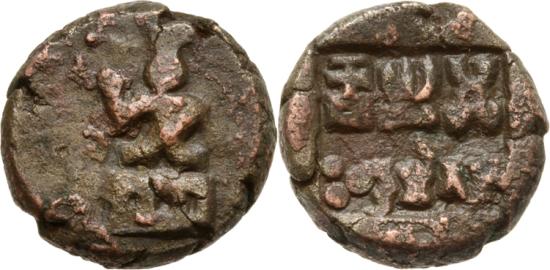
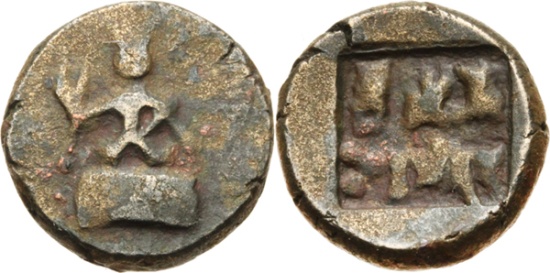
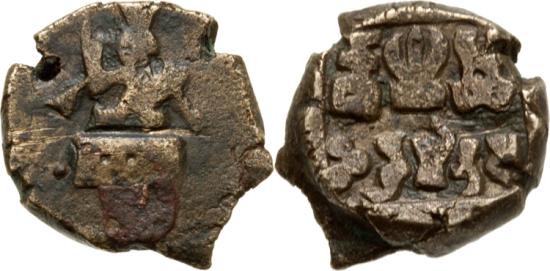
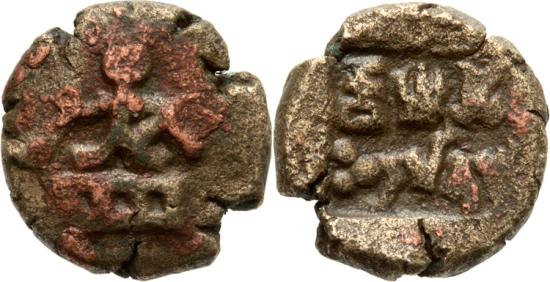
https://www.vcoins.com/en/stores/nemesis_ancients/110/product/india__kingdom_of_panchalas_ahichchhatra__indramitra_1_st_century_bc___karshapana/524537/Default.aspx
https://www.vcoins.com/en/stores/nemesis_ancients/110/product/india__kingdom_of_panchalas_ahichchhatra__indramitra_1_st_century_bc___karshapana/395393/Default.aspx

This is a coin of king Bhanumitra. The diameter is 21.5 mm and weight is 13.8 gms. This is a double karshapana and material is a tin-bronze alloy.
Obv. Brahmi legend bhanumitrasa in deep incuse below; above the legend two horizontally placed symbols like modifications of the third Panchala symbol.
Rev: Arch with three dots above on left and railed tree on right
Ref. Pieper 1018
Mitchiner MACW 4549, 26 mm, 10.3 grams. One side shows the Panchala symbols at the top within an incuse frame. There is only one character of the name Bhanumitra preserved at the bottom. The other side shows a radiant sun on a pedestal.
http://www.worldofcoins.eu/forum/index.php?topic=35022.0

Bhanumitra, AE double karshapana, c. 1-20 CE
Weight: 12.94 gm., Diam: ? mm.
Ref: MAC 4549 var. A gorgeous example of a more normal depiction of the radiate sun on a pedestal. (Photo courtesy Girish Sharma.)
 .
.
Bhanumitra, AE double karshapana, c. 1-20 CE
Weight: 12.58 gm., Diam: 25 mm.
Ref: MAC 4549 A very interesting coin, in which Bhanu (the sun) is depicted as a solar disc surrounded by emanating rays and is then garlanded with a pendant necklace ... a beautiful depiction!

Bhumimitra, AE double karshapana, c. 65-80 CE
Weight: 15.52 gm., Diam: 25 mm.Ref: MAC 4549..
Agni is depicted with flaming hair on the obverse.
http://coinindia.com/galleries-panchala-kingdom.html
I suggest that the three symbols are Indus Script Meluhha hieroglyphs read rebus as a mint metalwork catalogue.
Specifically, the three hypertexts signify that the mint works in tin-bronze alloy metalwork by metal artificers: ranku ayo kammaṭa sippi 'tin, alloy metal mint artificer'.
From l. to r.:
Hypertext 1: ranku 'liquid measure' rebus: ranku 'tin' PLUS sal 'splinter' rebus: sal 'workshop'
Hypertext 2: mēḍhā 'twist' rebus med 'iron' med '
Hypertext 3: ayo 'fish' PLUS khambhaṛā 'fin' rebus: aya 'iron' ayas 'metal alloy' PLUS kammaTa 'mint, coiner, coinage' PLUS गोटी [ gōṭī ] f (Dim. of गोटा) A roundish stone or pebble. 2 A marble. 3 A large lifting stone.rebus: gōṭa 'ferrous, laterite ore' khōṭa 'ingot, wedge'
dala 'petal' Rebus: ḍhāḷako = a large ingot (G.) ḍhāḷakī = a metal heated and poured into a mould; a solid piece of metal; an ingot (Gujarati)
See: http://bharatkalyan97.blogspot.in/2017/01/monetisation-of-hindu-rastram-from.html Mirror: http://tinyurl.com/zztyzkf for a rebus reading of a comparable hypertext on a Taxila coin 185-168 BCE.
Triratna? on Taxila coin 185-168 BCE detail http://www.cngcoins.com
https://commons.wikimedia.org/wiki/File:Triratna_on_Taxila_coin_185-168_BCE_detail.jpg#/media/File:Triratna_on_Taxila_coin_185-168_BCE_detail.jpg
This is an Indus Script hypertext. ayo 'fish' rebus: aya 'iron' ayas 'alloy metal' (Rigveda) khambhaṛā 'fish-fin' Rebus: kammaṭi a coiner (Ka.); kampaṭṭam coinage, coin, mint (Ta.) kammaṭa = mint, gold furnace (Te.) kamaṭa = portable furnace for melting precious metals (Telugu) PLUS gōṭā m A roundish stone or pebble. 2 A marble (of stone, lac, wood &c.) 2 A marble. 3 A large lifting stone Rebus: khoTa 'ingot' PLUS dula 'two' rebus: dul 'metal casting' PLUS dala 'petal' Rebus: ḍhāḷako = a large ingot (G.) ḍhāḷakī = a metal heated and poured into a mould; a solid piece of metal; an ingot (Gujarati)
Obv: Indra standing on pedestal, holding uncertain object in right hand
Rev: Panchala symbols above legend; Brahmi legend - Indramitrasa

OBVERSE: God Indra on pedestal
REVERSE: Incuse Square with the symbols of the Panchala Kingdom and the Kings name
16 mm - 4.5 grams

OBVERSE: Incuse Square with the symbols of the Panchala Kingdom and the Kings name
REVERSE: God Indra on pedestal
REVERSE: God Indra on pedestal
16 mm - 4.8 grams
India. Panchalas. Indramitra. 1st cent. BCE. 1/2 karshapana
OBVERSE: God Indra on pedestal
REVERSE: Incuse Square with the symbols of the Panchala Kingdom and the Kings name
15 mm - 4.5 grams
MAC 4539

OBVERSE: Incuse Square with the symbols of the Panchala Kingdom and the Kings name
REVERSE: God Indra on pedestal
REVERSE: God Indra on pedestal
15 mm - 4.5 grams
MAC 4539
https://www.vcoins.com/en/stores/nemesis_ancients/110/product/india__kingdom_of_panchalas_ahichchhatra__indramitra_1_st_century_bc___karshapana/395388/Default.aspxhttps://www.vcoins.com/en/stores/nemesis_ancients/110/product/india__kingdom_of_panchalas_ahichchhatra__indramitra_1_st_century_bc___karshapana/524537/Default.aspx
https://www.vcoins.com/en/stores/nemesis_ancients/110/product/india__kingdom_of_panchalas_ahichchhatra__indramitra_1_st_century_bc___karshapana/395393/Default.aspx
This is a coin of king Bhanumitra. The diameter is 21.5 mm and weight is 13.8 gms. This is a double karshapana and material is a tin-bronze alloy.
Obv. Brahmi legend bhanumitrasa in deep incuse below; above the legend two horizontally placed symbols like modifications of the third Panchala symbol.
Rev: Arch with three dots above on left and railed tree on right
Ref. Pieper 1018
AE-Tin Double Karshapana of Bhanumitra,Panchalas of Ahichhatra :Secondary series
Mitchiner MACW 4549, 26 mm, 10.3 grams. One side shows the Panchala symbols at the top within an incuse frame. There is only one character of the name Bhanumitra preserved at the bottom. The other side shows a radiant sun on a pedestal.
http://www.worldofcoins.eu/forum/index.php?topic=35022.0
Bhanumitra, AE double karshapana, c. 1-20 CE
Weight: 12.94 gm., Diam: ? mm.
Ref: MAC 4549 var. A gorgeous example of a more normal depiction of the radiate sun on a pedestal. (Photo courtesy Girish Sharma.)
Bhanumitra, AE double karshapana, c. 1-20 CE
Weight: 12.58 gm., Diam: 25 mm.
Ref: MAC 4549 A very interesting coin, in which Bhanu (the sun) is depicted as a solar disc surrounded by emanating rays and is then garlanded with a pendant necklace ... a beautiful depiction!
Bhumimitra, AE double karshapana, c. 65-80 CE
Weight: 15.52 gm., Diam: 25 mm.Ref: MAC 4549..
Agni is depicted with flaming hair on the obverse.
http://coinindia.com/galleries-panchala-kingdom.html





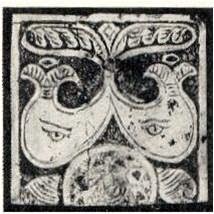


Comments